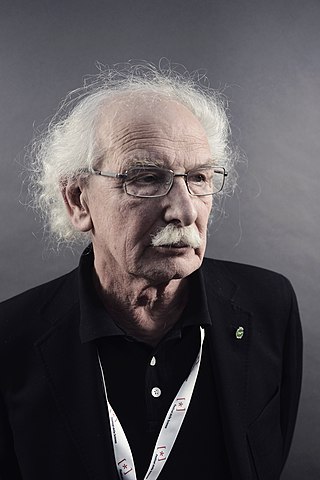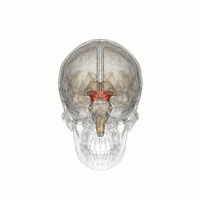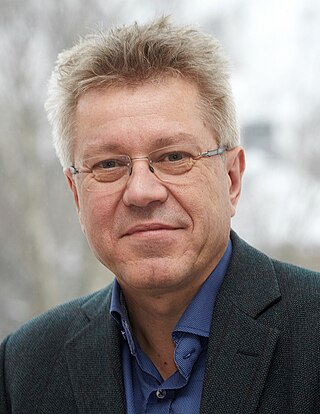Related Research Articles

Bipedalism is a form of terrestrial locomotion where a tetrapod moves by means of its two rear limbs or legs. An animal or machine that usually moves in a bipedal manner is known as a biped, meaning 'two feet'. Types of bipedal movement include walking or running and hopping.

Neuroscience is the scientific study of the nervous system, its functions and disorders. It is a multidisciplinary science that combines physiology, anatomy, molecular biology, developmental biology, cytology, psychology, physics, computer science, chemistry, medicine, statistics, and mathematical modeling to understand the fundamental and emergent properties of neurons, glia and neural circuits. The understanding of the biological basis of learning, memory, behavior, perception, and consciousness has been described by Eric Kandel as the "epic challenge" of the biological sciences.

A gait is a manner of limb movements made during locomotion. Human gaits are the various ways in which humans can move, either naturally or as a result of specialized training. Human gait is defined as bipedal forward propulsion of the center of gravity of the human body, in which there are sinuous movements of different segments of the body with little energy spent. Varied gaits are characterized by differences such as limb movement patterns, overall velocity, forces, kinetic and potential energy cycles, and changes in contact with the ground.

The subthalamic nucleus (STN) is a small lens-shaped nucleus in the brain where it is, from a functional point of view, part of the basal ganglia system. In terms of anatomy, it is the major part of the subthalamus. As suggested by its name, the subthalamic nucleus is located ventral to the thalamus. It is also dorsal to the substantia nigra and medial to the internal capsule. It was first described by Jules Bernard Luys in 1865, and the term corpus Luysi or Luys' body is still sometimes used.

Knuckle-walking is a form of quadrupedal walking in which the forelimbs hold the fingers in a partially flexed posture that allows body weight to press down on the ground through the knuckles. Gorillas and chimpanzees use this style of locomotion, as do anteaters and platypuses.
Central pattern generators (CPGs) are self-organizing biological neural circuits that produce rhythmic outputs in the absence of rhythmic input. They are the source of the tightly-coupled patterns of neural activity that drive rhythmic and stereotyped motor behaviors like walking, swimming, breathing, or chewing. The ability to function without input from higher brain areas still requires modulatory inputs, and their outputs are not fixed. Flexibility in response to sensory input is a fundamental quality of CPG-driven behavior. To be classified as a rhythmic generator, a CPG requires:
- "two or more processes that interact such that each process sequentially increases and decreases, and
- that, as a result of this interaction, the system repeatedly returns to its starting condition."
In physiology, motor coordination is the orchestrated movement of multiple body parts as required to accomplish intended actions, like walking. This coordination is achieved by adjusting kinematic and kinetic parameters associated with each body part involved in the intended movement. The modifications of these parameters typically relies on sensory feedback from one or more sensory modalities, such as proprioception and vision.

The olfactory tubercle (OT), also known as the tuberculum olfactorium, is a multi-sensory processing center that is contained within the olfactory cortex and ventral striatum and plays a role in reward cognition. The OT has also been shown to play a role in locomotor and attentional behaviors, particularly in relation to social and sensory responsiveness, and it may be necessary for behavioral flexibility. The OT is interconnected with numerous brain regions, especially the sensory, arousal, and reward centers, thus making it a potentially critical interface between processing of sensory information and the subsequent behavioral responses.
From the ancient Egyptian mummifications to 18th-century scientific research on "globules" and neurons, there is evidence of neuroscience practice throughout the early periods of history. The early civilizations lacked adequate means to obtain knowledge about the human brain. Their assumptions about the inner workings of the mind, therefore, were not accurate. Early views on the function of the brain regarded it to be a form of "cranial stuffing" of sorts. In ancient Egypt, from the late Middle Kingdom onwards, in preparation for mummification, the brain was regularly removed, for it was the heart that was assumed to be the seat of intelligence. According to Herodotus, during the first step of mummification: "The most perfect practice is to extract as much of the brain as possible with an iron hook, and what the hook cannot reach is mixed with drugs." Over the next five thousand years, this view came to be reversed; the brain is now known to be the seat of intelligence, although colloquial variations of the former remain as in "memorizing something by heart".

Stanislas Dehaene is a French author and cognitive neuroscientist whose research centers on a number of topics, including numerical cognition, the neural basis of reading and the neural correlates of consciousness. As of 2017, he is a professor at the Collège de France and, since 1989, the director of INSERM Unit 562, "Cognitive Neuroimaging".

Giacomo Rizzolatti is an Italian neurophysiologist who works at the University of Parma. Born in Kyiv, UkSSR, he is the Senior Scientist of the research team that discovered mirror neurons in the frontal and parietal cortex of the macaque monkey, and has written many scientific articles on the topic. He also proposed the premotor theory of attention. He is a past president of the European Brain and Behaviour Society. Rizzolatti was the 2007 co-recipient, with Leonardo Fogassi and Vittorio Gallese, for the University of Louisville Grawemeyer Award for Psychology. He is an elected member of the Academia Europaea, National Academy of Sciences, and Royal Society In 2020 he adheres to Empathism.

The evolution of human bipedalism, which began in primates approximately four million years ago, or as early as seven million years ago with Sahelanthropus, or approximately twelve million years ago with Danuvius guggenmosi, has led to morphological alterations to the human skeleton including changes to the arrangement, shape, and size of the bones of the foot, hip, knee, leg, and the vertebral column. These changes allowed for the upright gait to be overall more energy efficient in comparison to quadrupeds. The evolutionary factors that produced these changes have been the subject of several theories that correspond with environmental changes on a global scale.

Spinal locomotion results from intricate dynamic interactions between a central program in lower thoracolumbar spine and proprioceptive feedback from body in the absence of central control by brain as in complete spinal cord injury (SCI). Following SCI, the spinal circuitry below the lesion site does not become silent; rather, it continues to maintain active and functional neuronal properties, although in a modified manner.
Space neuroscience or astroneuroscience is the scientific study of the central nervous system (CNS) functions during spaceflight. Living systems can integrate the inputs from the senses to navigate in their environment and to coordinate posture, locomotion, and eye movements. Gravity has a fundamental role in controlling these functions. In weightlessness during spaceflight, integrating the sensory inputs and coordinating motor responses is harder to do because gravity is no longer sensed during free-fall. For example, the otolith organs of the vestibular system no longer signal head tilt relative to gravity when standing. However, they can still sense head translation during body motion. Ambiguities and changes in how the gravitational input is processed can lead to potential errors in perception, which affects spatial orientation and mental representation. Dysfunctions of the vestibular system are common during and immediately after spaceflight, such as space motion sickness in orbit and balance disorders after return to Earth.

The Golgi tendon organ (GTO) is a proprioceptor – a type of sensory receptor that senses changes in muscle tension. It lies at the interface between a muscle and its tendon known as the musculotendinous junction also known as the myotendinous junction. It provides the sensory component of the Golgi tendon reflex.

The mesencephalic locomotor region (MLR) is a functionally defined area of the midbrain that is associated with the initiation and control of locomotor movements in vertebrate species.

Ole Kiehn is a Danish-Swedish neuroscientist. He is Professor of Integrative Neuroscience at the Department of Neuroscience, University of Copenhagen, Denmark, and professor of neurophysiology at Karolinska Institute, Sweden.
Rae Silver is a Canadian behavioral neuroendocrinologist and neuroscientist best known for her research on the role of the suprachiasmatic nucleus (SCN) of the hypothalamus in generating circadian rhythms, the role of mast cells in the brain, the physiological mechanisms of parental behavior in ring doves. She is currently the Helene L. and Mark N. Kaplan Professor of Natural & Physical Sciences and is currently the Chair of the Neuroscience Program and Professor of Psychology at Barnard College. In addition, she is jointly appointed as a Professor in the Department of Psychology at Columbia University and in the Department of Pathology and Cell Biology with the Columbia College of Physicians and Surgeons.
A descending neuron is a neuron that conveys signals from the brain to neural circuits in the spinal cord (vertebrates) or ventral nerve cord (invertebrates). As the sole conduits of information between the brain and the body, descending neurons play a key role in behavior. Their activity can initiate, maintain, modulate, and terminate behaviors such as locomotion. Because the number of descending neurons is several orders of magnitude smaller than the number of neurons in either the brain or spinal cord/ventral nerve cord, this class of cells represents a critical bottleneck in the flow of information from sensory systems to motor circuits.
Giovanni Berlucchi is an Italian physiologist, academic, and author. He is a professor Emeritus at the Department of Neurosciences, Biomedicine, and Movement Sciences at the University of Verona.
References
- ↑ "Università degli Studi Tor Vergata. DidatticaWeb".
- ↑ "Università degli Studi di Roma Tor Vergata. Facoltà di Medicina e Chirurgia. Dipartimento di Medicina dei Sistemi. Lacquaniti Francesco". Archived from the original on 2021-04-30. Retrieved 2020-07-30.
- ↑ "Santa Lucia Neuroscienze e Riabilitazione. Innovative Methodologies for Rehabilitation". Archived from the original on 2023-06-04. Retrieved 2020-07-30.
- ↑ Incognito. Pantheon Books. 2011. ISBN 9780307379788.
- ↑ Biological Learning and Control. Computational Neuroscience Series. MIT Press. 27 January 2012. ISBN 9780262016964.
- ↑ Synergy. Oxford University Press. 20 March 2008. ISBN 978-0-19-533316-9.
- ↑ Textbook of Pediatric Neurosurgery. Springer. 2020. ISBN 9783319721675.
- ↑ "Knowledge of gravity hard-wired in the brain" . Retrieved 30 July 2020.
- ↑ "Humans learn to walk like rats" . Retrieved 30 July 2020.
- ↑ "Tottering piglets can't walk at first but learn super-fast" . Retrieved 30 July 2020.
- ↑ "A Rat's First Steps: How Humans and Other Animals Learn to Walk". The Atlantic . 17 November 2011. Retrieved 31 July 2020.
- ↑ "Der Standard. Wie wir wirklich gehen lernen".
- ↑ "Babies, rats share walking ancestry" . Retrieved 30 July 2020.
- ↑ "Los primeros pasos de niños y animales comparten un mecanismo neuronal similar" . Retrieved 30 July 2020.
- ↑ "Medical Xpress. New insights into how humans learn to walk".
- ↑ "Premio Herlitzka".
- ↑ "Consiglio Universitario Nazionale. Archivio Storico".
- ↑ "Academia Europaea. Members. Francesco Lacquaniti".
- ↑ "Deux brillants specialistes du contrôle moteur".